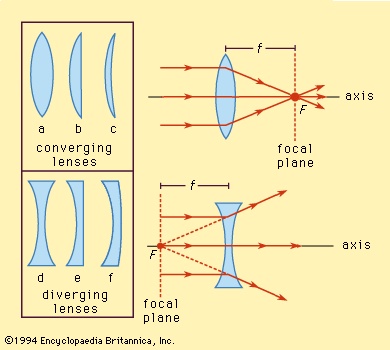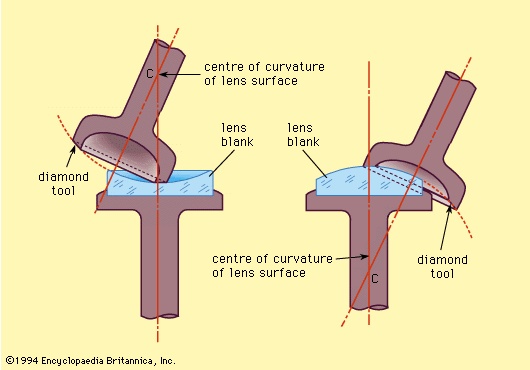lens
eye
in anatomy, a nearly transparent biconvex structure suspended behind the iris of the eye, the sole function of which is to focus light rays onto the retina. The lens is made up of unusual elongated cells that have no blood supply but obtain nutrients from the surrounding fluids, mainly the aqueous humour that bathes the front of the lens. Waste products are removed through these fluids as well. The shape of the lens can be altered by the relaxation and contraction of the ciliary muscles surrounding it, thus enabling the eye to focus clearly on objects at widely varying distances. The ability of the lens to adjust from a distant to a near focus, called accommodation, gradually declines with age (a condition called presbyopia), often requiring correction. Clouding or opacity of the lens, called a cataract, may also occur with age. Cataracts that interfere with vision can be corrected by surgery, during which the clouded lens is removed and replaced with an artificial lens.
optics
in optics, piece of glass or other transparent substance that is used to form an image of an object by focusing rays of light from the object. A lens is a piece of transparent material, usually circular in shape, with two polished surfaces, either or both of which is curved and may be either convex (bulging) or concave (depressed). The curves are almost always spherical, i.e., the radius of curvature is constant. A lens has the valuable property of forming images of objects situated in front of it. Single lenses are used in eyeglasses, contact lenses, pocket magnifiers, projection condensers, signal lights, viewfinders, and on simple box cameras. More often a number of lenses made of different materials are combined together as a compound lens in a tube to permit the correction of aberrations. Compound lenses are used in such instruments as cameras, microscopes, and telescopes.
A lens produces its focusing effect because light travels more slowly in the lens than in the surrounding air, so that refraction, an abrupt bending, of a light beam occurs both where the beam enters the lens and where it emerges from the lens into the air.


 A single lens has two precisely regular opposite surfaces; either both surfaces are curved, or one is curved and one is plane. Lenses may be classified according to their two surfaces as biconvex (a in Figure 1-->
A single lens has two precisely regular opposite surfaces; either both surfaces are curved, or one is curved and one is plane. Lenses may be classified according to their two surfaces as biconvex (a in Figure 1--> ), plano-convex (b), concavo-convex (c; converging meniscus), biconcave (d), plano-concave (e), and convexo-concave (f; diverging meniscus). Because of the curvature of the lens surfaces, different rays of an incident light beam are refracted through different angles, so that an entire beam of parallel rays can be caused to converge on, or to appear to diverge from, a single point. This point is called the focal point, or principal focus, of the lens, as shown on the right of Figure 1-->
), plano-convex (b), concavo-convex (c; converging meniscus), biconcave (d), plano-concave (e), and convexo-concave (f; diverging meniscus). Because of the curvature of the lens surfaces, different rays of an incident light beam are refracted through different angles, so that an entire beam of parallel rays can be caused to converge on, or to appear to diverge from, a single point. This point is called the focal point, or principal focus, of the lens, as shown on the right of Figure 1--> . Refraction of the rays of light reflected from or emitted by an object causes the rays to form a visual image of the object. This image may be either real—photographable or visible on a screen—or virtual—visible only upon looking into the lens, as in a microscope. The image may be much larger or smaller than the object, depending on the focal length (see Figure 1-->
. Refraction of the rays of light reflected from or emitted by an object causes the rays to form a visual image of the object. This image may be either real—photographable or visible on a screen—or virtual—visible only upon looking into the lens, as in a microscope. The image may be much larger or smaller than the object, depending on the focal length (see Figure 1--> ) of the lens and on the distance between the lens and the object. The focal length of a lens is the distance from the centre of the lens to the point at which the image of a distant object is formed. A long-focus lens forms a larger image of a distant object, while a short-focus lens forms a small image.
) of the lens and on the distance between the lens and the object. The focal length of a lens is the distance from the centre of the lens to the point at which the image of a distant object is formed. A long-focus lens forms a larger image of a distant object, while a short-focus lens forms a small image. Usually the image formed by a single lens is not good enough for precise work in such fields as astronomy, microscopy, and photography; this is because the cone of rays emitted by a single point in a distant object is not united in a perfect point by the lens but instead forms a small patch of light. This and other innate imperfections in a lens's image of a single object point are known as aberrations. To correct such aberrations, it is often necessary to combine in one mount several lens elements (single lenses), some of which may be convex and some concave, some made of dense high-refractive or high-dispersive glass, and others made of low-refractive or low-dispersive glass. The lens elements may be cemented together or mounted at carefully calculated separations to correct the aberrations of the individual elements and obtain an image of acceptable sharpness (see also aberration). The precise mounting also ensures that all lenses are properly centred; that is, the centres of curvature of all the lens surfaces lie on a single straight line called the principal axis of the lens. A frequently used measure of the quality of any lens system is its ability to form an image that is sharp enough to separate, or resolve, two very close dots or lines in an object. Resolving power depends on how well the various aberrations in a lens system are corrected.
The simplest compound lens is a thin cemented combination of two single lenses, such as that used in the objective (the lens nearest the object) of a small refracting telescope. Microscope objectives may contain as many as eight or nine elements, some of which may be made of different materials in order to bring all colours of light to a common focus, and thus prevent chromatic aberration. The objective lenses used in cameras may contain from two to 10 elements, while a so-called zoom or variable-focal length lens may have as many as 18 or 20 elements in several groups, the different groups being movable along the axis by levers or cams in order to produce the desired change in focal length without a shift of the focal plane. Lenses also vary greatly in diameter, from as small as 0.16 cm (1/16 inch) for an element in a microscope objective to as large as 100 cm (40 inches) for an astronomical telescope objective. In reflectors and several other types of astronomical telescopes, concave mirrors are used for the objective instead of lenses.
 In the manufacture of lenses, slabs of glass are cut with a glass saw or slitting disk; a piece of the desired type and shape is chipped to a rough, round blank, or the pieces may be heated to softness, rolled to a round shape, and pressed in a mold to the desired size and to approximately the desired curvature of the surfaces. The surfaces are then ground, or lapped, to the final form, using coarse emery, carborundum, or diamond as an abrasive. Lens surfaces are ground on an iron tool, either flat or suitably curved, using progressively finer grades of one of the abrasives mentioned above. In the grinding process, a rotating cup-shaped tool is mounted so that its axis of rotation intersects the axis of the lens at the centre of curvature, C, of the desired spherical surface. (See Figure 2-->
In the manufacture of lenses, slabs of glass are cut with a glass saw or slitting disk; a piece of the desired type and shape is chipped to a rough, round blank, or the pieces may be heated to softness, rolled to a round shape, and pressed in a mold to the desired size and to approximately the desired curvature of the surfaces. The surfaces are then ground, or lapped, to the final form, using coarse emery, carborundum, or diamond as an abrasive. Lens surfaces are ground on an iron tool, either flat or suitably curved, using progressively finer grades of one of the abrasives mentioned above. In the grinding process, a rotating cup-shaped tool is mounted so that its axis of rotation intersects the axis of the lens at the centre of curvature, C, of the desired spherical surface. (See Figure 2--> .) The obliquity of the tool axis must be adjusted so that the rim of the tool cuts across the centre of the (concave) lens being generated. For convex lenses, the centre of the rotating tool face cuts the rim of the lens blank. As both tool and lens rotate about their respective axes, a spherical surface of the desired radius of curvature is generated on the lens.
.) The obliquity of the tool axis must be adjusted so that the rim of the tool cuts across the centre of the (concave) lens being generated. For convex lenses, the centre of the rotating tool face cuts the rim of the lens blank. As both tool and lens rotate about their respective axes, a spherical surface of the desired radius of curvature is generated on the lens.Fine grinding, or smoothing, is done using carefully graded emery flour as an abrasive. A number of fine-ground lens blanks are then mounted with pitch on a block so that they can be polished together. The polishing tool is covered with a thin layer of pitch, wax, or even coarse cloth, and wet rouge or certain other mineral oxides are also used as polishing agents. The polishing of glass is a slow process, requiring lenses to be oscillated back and forth, sometimes for hours, against the rotating polisher. After both sides have been polished, the lens is ground around the edge to centre it and give it the correct diameter. If a compound objective is being made, several single lenses must be mounted together in a precise coaxial arrangement, and their thicknesses, separations, and centring must be kept very close to the prescribed values, or the aberration corrections laboriously determined by the lens designer will not be realized. The finished lens's resolving power is then tested by using the lens to form an image of a point source or other suitable test object. Sophisticated variants of this basic testing procedure have been developed using photoelectric cells or interferometers to obtain greater measuring accuracy.
- Iskandarīyah, Al-
- Iskander, Fazil
- Iskŭr River
- Isla de la Juventud
- Isla del Sol
- Isla, José Francisco de
- Islamabad
- Islamic Art, Museum of
- Islamic arts
- Islamic caste
- Islamic Conference, Organization of the
- Islam, Pillars of
- island
- island arc
- Island of Capri
- Island of Ischia
- Island of Mozambique
- Island of Procida
- Islands, Bay of
- Islay
- Isle of Anglesey
- Isle of Axholme
- Isle of Ely
- Isle of Man
- Isle of Man, flag of the